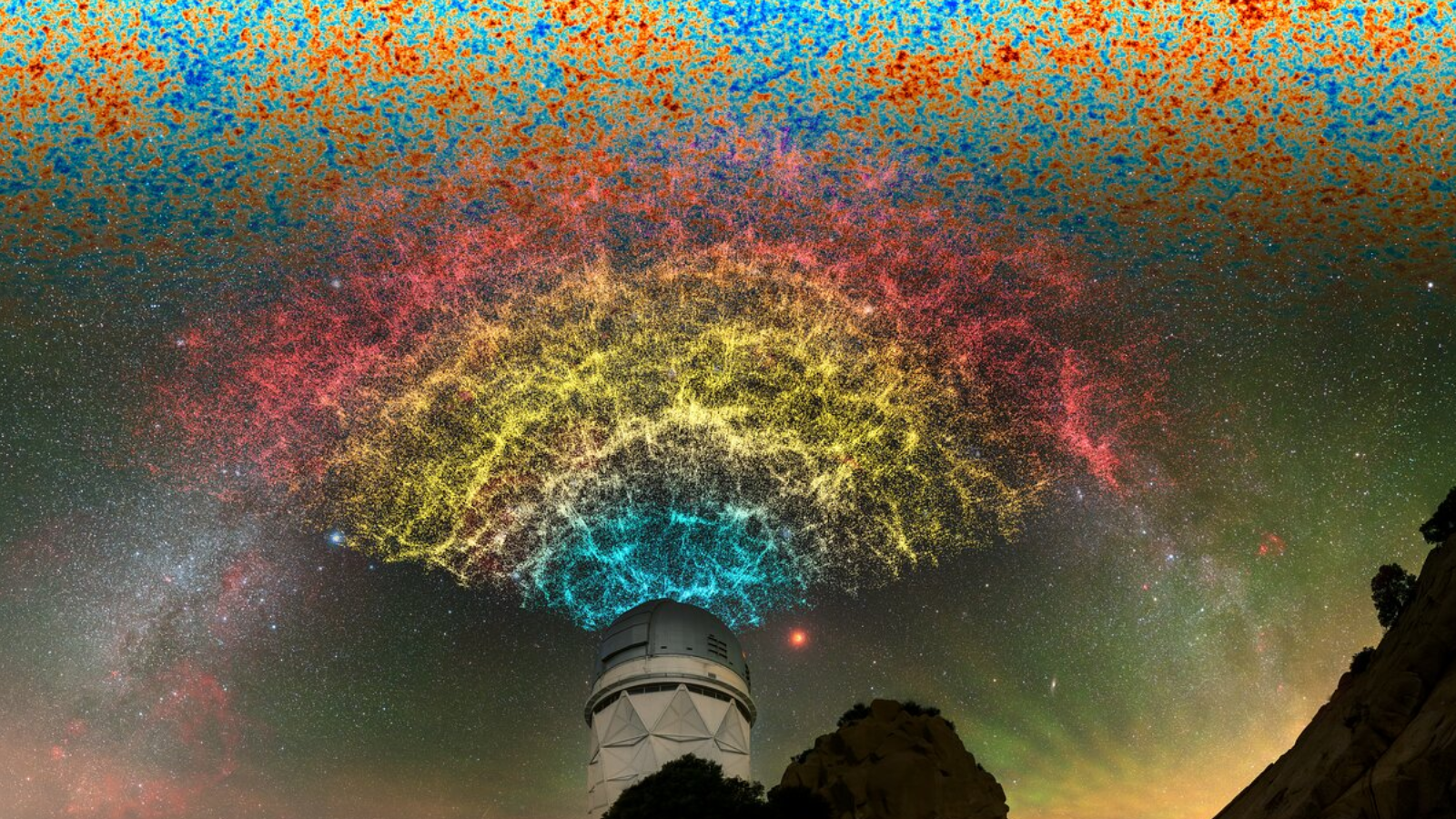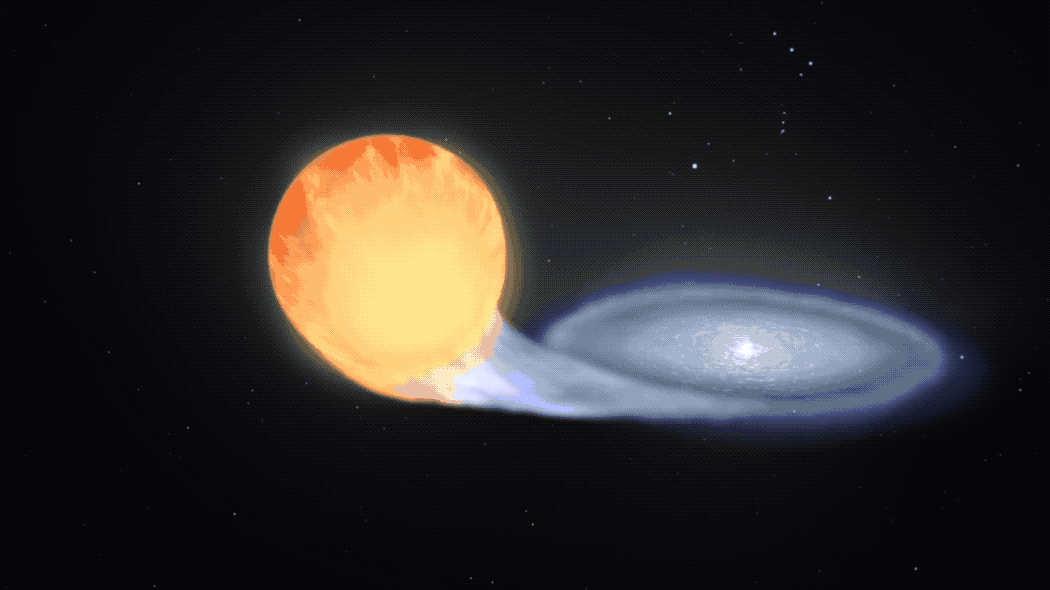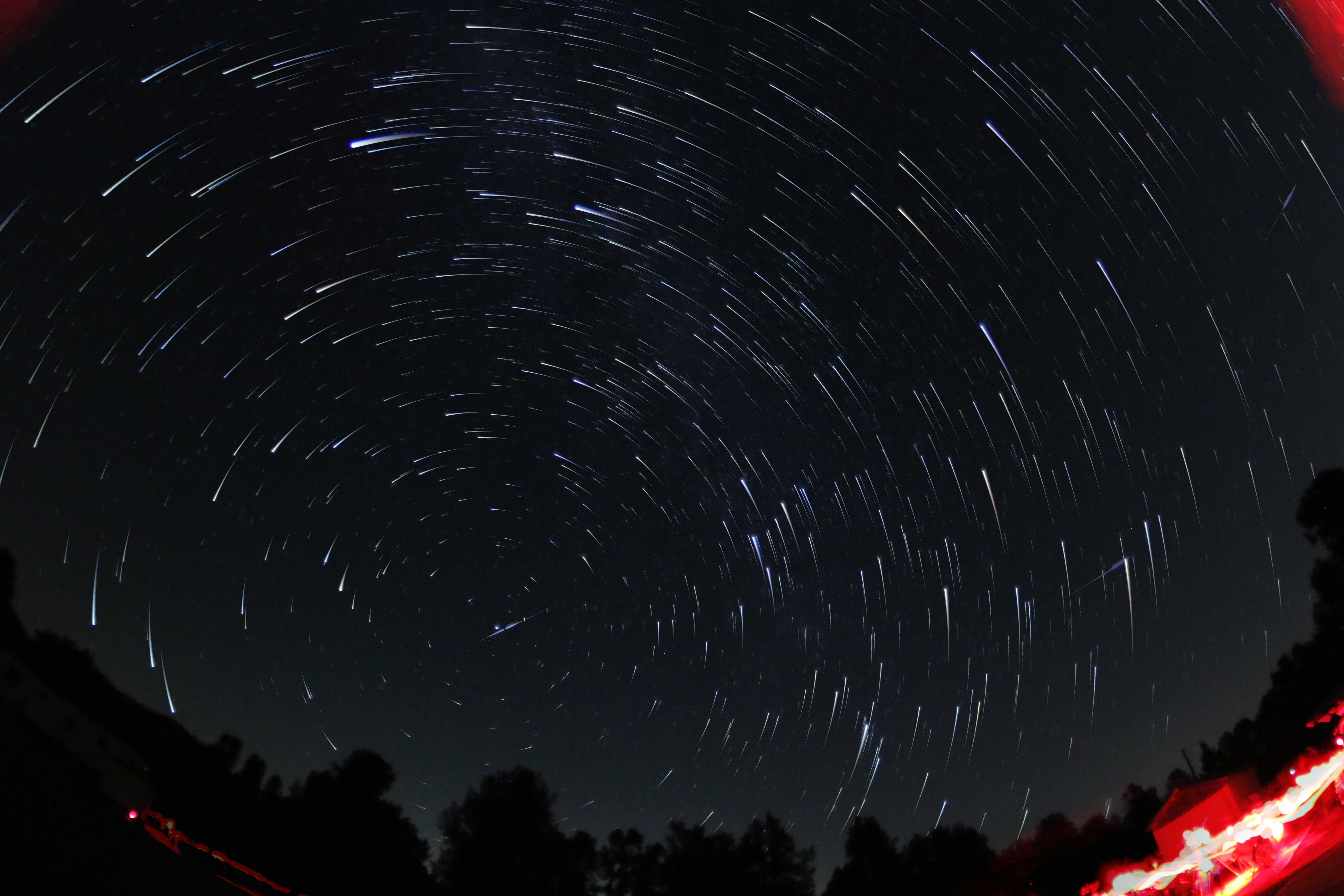Dark energy could be getting weaker, suggesting the universe will end in a 'Big Crunch'
"The discovery of evolving dark energy would be as revolutionary as the discovery of the accelerated expansion of the universe itself, if confirmed."

The current "standard model" of the cosmos, its history, and its evolution is called the Lambda Cold Dark Matter (LCDM) model — but the supremacy of this model, in which lambda represents the cosmological constant and dark energy, may now be under serious threat.
In short, that is because new observations of the cosmos have suggested that dark energy, the force causing our universe to expand faster and faster, seems to be weakening. That may not sound like much in and of itself, but this finding actually has the potential to cause the first major paradigm shift in cosmology since the discovery of the accelerated expansion of the universe just over 25 years ago. It could even suggest out universe won't end in a "Big Rip," or a "Big Chill," but rather a "Big Crunch." More on that shortly, first, let's dive into these fascinating results.
Related: Largest 3D map of our universe could hint that dark energy evolves with time
The new clues about dark energy evolving came as part of one of the deepest maps of the cosmos ever created, built using the first year of data collected by the Dark Energy Spectroscopic Instrument (DESI). The instrument's 5,000 robotic eyes collect light from millions of galaxies across over a third of the entire sky as we see it from Earth. This light is then broken down into a spectrum of colors, allowing scientists to measure the expansion of the universe over billions of years by measuring a change in light wavelength called "redshift."
Collected over no more than a fifth of DESI's mission operating time, data gleaned with the survey already promises major shake-ups and has cosmologists excited about what comes next.
"The release of these results was a great day for cosmology, pointing to a 'decreasing' effect of the dark energy over time, meaning it is evolving and, therefore, not constant after all," Luz Ángela García Peñaloza, former DESI team member and a cosmologist at the Universidad ECCI in Columbia, told Space.com. "The discovery of evolving dark energy would be as revolutionary as the discovery of the accelerated expansion of the universe itself, if confirmed with future data."
What is the standard model of cosmology?
The LCDM model suggests that, immediately following the Big Bang, the universe was majorly dense and incredibly hot — but also remarkably smooth and more or less the same, or homogenous, in all directions.
Breaking space news, the latest updates on rocket launches, skywatching events and more!
As the universe expanded, small fluctuations in density began to appear, and these dense patches grew. Clumps of dark matter began to condense as the universe evolved, and newly formed atoms gathered and spurred gas molecules within these clumps. This resulted in a universe filled with little more than hydrogen and helium (the two lightest and simplest chemical elements) — and dark matter.
The bonding of electrons to protons to create the first atoms meant that light was suddenly free to travel, and this first light is seen today as the cosmic microwave background (CMB), "fossil" radiation that can tell us a lot about the history of the universe.
Regions of higher density drew gas and dark matter together, forming the seeds for the first galaxies in the LCDM model that collapsed to birth proto-galaxies. In these early galaxies, the hydrogen and helium gas created the first stars. Finally, proto-galaxies and the halos around them merged to form larger and larger galaxies.
Importantly, however, in this model, dark energy is represented by lambda. And lambda is supposed to be constant over time.
"DESI saw that the 'equation of state' of the universe isn't consistent with the usual LCDM model, but instead, it is showing a hint that dark energy is varying with time," García Peñaloza said. "These findings open a window for variable dark energy models because they show a departure for the constant equation of state.
"This was pretty surprising because most cosmological observations thus far have favored the LCDM model. The entire cosmological community was really shocked."
If these novel findings from DESI prove accurate — and they are currently extremely robust, it would appear — then the cosmological constant may no longer be a suitable representative for the mysterious force of dark energy.
Some physicists may welcome doing away with the cosmological constant, however. Not only has it been a headache for decades, but this wouldn't be the first time that our burgeoning understanding of the cosmos had warranted its disposal.
Back to the theoretical dustbin
The cosmological constant, represented by the Greek letter Lambda, has posed quite the problem for physicists since the early 20th century.
In 1915, Albert Einstein released what is arguably his most revolutionary theory, general relativity, which described gravity as a concept that emerges from the curvature of space and time — a curvature caused by bodies with mass.
Two years after this, in 1917, Einstein and Dutch astronomer Willem de Sitter demonstrated that the equations of general relativity could be used to describe the universe, albeit a highly simplified universe. There was a problem, however; the universe described by the equations of general relativity didn't describe a universe that sits still. At that time, in physics, the general consensus was that the universe was static, neither expanding nor contracting, and Einstein agreed with that consensus. So, he added a sort of "fudge factor" to his equations: The cosmological constant, or lambda.
This balanced the universe, adding the right push and pull to keep it static.

Around 12 years later, in 1929, Edwin Hubble was studying distant galaxies and found that light from them was being stretched, or "redshifted." The further away a galaxy was, he saw, the greater this effect was. This indicated that the universe was not static but was, in fact, expanding. Scientists would spend the next seven decades trying to measure the rate of this expansion, determined by a value called the "Hubble constant."
No longer needing to describe a static universe, Einstein removed the cosmological constant from his equations of the universe, allegedly describing the introduction of lambda as his "greatest blunder." But the cosmological constant wouldn't stay in the cosmic dustbin for long. Before the end of the 20th century, lambda would be back in a big way, and with a new role.

In 1998, two separate teams of astronomers were making observations of distant Type1a supernovas and using them as cosmic distance measurements when they discovered that the expansion of the universe isn't actually slowing as one might expect. It's speeding up. Then, dark energy was introduced as a placeholder for whatever seems to be causing this accelerating expansion.
"Despite the fact that it makes up 70% of the universe's total matter and energy budget, nobody knows what it is," García Peñaloza said.
In many models of the cosmos, including the prevalent LCDM model, dark energy is represented by the rescued cosmological constant, or lambda, that's now acting to oppose gravity and push the very fabric of space and time apart at a quickening rate.
Still, after being introduced as a value for the accelerating expansion of space, the cosmological constant remained a problem. Values delivered by observing distant supernovas and the value predicted by theories of quantum physics continue to vary wildly, diverging by as much as 10 to the power of 121 (1 followed by 121 zeroes).
Are any closer to understanding dark energy?
To understand why dark energy and the accelerating expansion of the universe is so shocking, consider this very Earthly analogy: Imagine giving a child on a swing one big push. That is analogous to the Big Bang, which kicked off the expansion of the universe. Over time, the swing would probably slow and reaches progressively lower points in its arc, right? That's akin to the expansion of the universe slowing down as the cosmos ages.
But then, suddenly, without you applying a further push when the swing has almost come to a halt, imagine that it suddenly resumes moving. Not only this, but imagine that it swings faster and faster, reaching higher and higher points. That is equivalent to the action of dark energy that the cosmological constant is used to describe.
It's no wonder scientists are eager to determine the cause of this extra cosmic push; the discovery that dark energy seems to be getting weaker adds a layer of complexity to the situation.
"This is a really good indication that maybe an LCDM model is not exactly 'the ultimate answer' to the nature of dark energy," García Peñaloza explained. "It's huge progress, but these results probably don't get us much closer to that answer; they are more telling us is more how to describe dark energy with a bearing to time, probably as a fluid that fills the universe and can be described with an equation of a state that is not constant."

Returning to the swing analogy, discovering what caused the extra, unseen push is critical to understanding the fate of the child on that swing: Will they land in the bushes, safely on the ground or get launched into space? Similarly, understanding dark energy is critical because its evolution, or lack thereof, will determine the fate of the universe. It could even show us what our view from Earth may look like in the future.
"There is one scenario in which, if dark energy is the unchanging cosmological constant, in eons, all the galaxies will have moved so far away from each other that the night sky over Earth will be empty," García Peñaloza said.
This could result in the universe ending as a cold cosmos of widely separated dead galaxies, the so-called "Big Chill" scenario. Alternatively, the continued accelerated expansion could cause the very fabric of spacetime to tear, a scenario called the "Big Rip."
The new DESI map, however, could indicate a different cosmic fate that sees the universe collapsing once again into the hot, dense state seen moments after the Big Bang. "If what the first year of DESI results suggests is true, then the accelerated expansion of the universe will cease and eventually reverse, and the universe could begin drawing together under the influence of gravity," García Peñaloza added. "This could eventually lead to the universe ending in a 'Big Crunch' scenario."
García Peñaloza and other cosmologist are keen to see what the next four years of DESI observations bring to our understanding of the universe, its origins and its fate.
In particular, García Peñaloza said that the second and third years of DESI operations should see the telescope exploring redshift space distortions, with this data making the already robust DESI results even more impressive. The final year of DESI results should coincide with the release of the first year of data from the Euclid space telescope, which launched on 1 July 2023, providing a powerful "double-punch" to our understanding of the universe.
"We're going to have a very complementary vision of the universe from two completely different missions," García Peñaloza concluded. "They are going give us a completely and brand new vision of how the universe is behaving and how dark energy is shaping the larger scale universal structure."
Join our Space Forums to keep talking space on the latest missions, night sky and more! And if you have a news tip, correction or comment, let us know at: community@space.com.

Robert Lea is a science journalist in the U.K. whose articles have been published in Physics World, New Scientist, Astronomy Magazine, All About Space, Newsweek and ZME Science. He also writes about science communication for Elsevier and the European Journal of Physics. Rob holds a bachelor of science degree in physics and astronomy from the U.K.’s Open University. Follow him on Twitter @sciencef1rst.
-
LordElfa This could, if true, point to a constantly repeating big bang/big crunch cycle of universal renewal.Reply -
G.nosticO.mniD.eity The law of Conservation of Mass Matter and Energy states that that mass, matter and energy are neither increased nor decreased...and Star Trek states: Ya' canna' change the laws of physics.Reply -
Unclear Engineer The BBT just makes up new physics to over-ride the effects of the existing laws.Reply -
Unclear Engineer So, is it a "defect" in Relativity Theory to believe that all comoving observers in the universe would observe the same velocity for light at all times, including all the way back to the Big Bang? If you believe that is not a defect, then you have a problem explaining homogeneity in the very early universe. Or, just maybe the BBT has the "defect", not GRT.Reply
"Inflation" is simply a way to override the General Relativity Theory result that a glob of matter representing the whole universe squeezed into a sub-atomic volume would not be able to expand against its own gravity. Inflation isn't explained. And it isn't constrained. It just is assumed to do whatever is needed to make the BBT work. And it is assumed to not do anything else that would make the BBT not work. Even if the something else seems like a logical extension of the something that is needed.
So, I stick by my original wording of my post. -
billslugg C is constant. Why don't you go measure it and show us the data saying it's not? Otherwise I'm going with the entire scientific community for the last 100 years versus an anonymous source.Reply
Inflation overrode gravity due to its energy. The Schwartzchild radius is for matter absent energy pushing it outward. -
Unclear Engineer Bill, I have measured he speed of light, myself.Reply
And I am not the one who is saying that the apparent speed of light must be different for (conceptual) observers in the very early universe - that is the result of the BBT saying that the light must have traveled across the whole early universe fast enough to keep it uniform in its parameters. That is the "horizon problem". But, we can't have it both ways. I am just pointing out the inconsistency between the 2 theories.
And, as far as we can tell, the Schwarzchild radius is applicable with the energies of all known forces. Nothing gets out, no matter what its charge level, kinetic energy, temperature, pressure, etc.
Yet, "inflation" is supposed to somehow have more energy than gravity. It would be able to explode our current black holes. So, why doesn't it? What happened that it expanded the very early universe, with far more mass in far less space than any of the black holes we now find, but it has no effect on our current black holes?
I'll add some thoughts about potential answers to that last point. "Inflation" is supposed to have expanded "space" and taken matter with the space as it expanded. That is to be consistent with General Relativity Theory not allowing matter to go through space at the speed of light (or faster). So, what would this look like from outside the expanding universe? Some people insist that is a forbidden question because their definition of "universe" says there is not any "outside". But, in fact, the frame of reference used by BBT theorists for the "very early universe" essentially assumes the view from outside, not inside. So, how would it have looked from inside? An astronomer's reference is relative to the inside of the universe.
Is it plausible that the view from inside a black hole (that we are outside of) looks to those inside like an expanding universe? I have read that is the case, but have not seen any general agreement on that. It would require a situation where the inside appears to be larger than the outside, at least from the frame of reference of those of us outside if we go inside. Sort of a "tardis" effect for those who are "Dr. Who" fans.
The whole BBT requires some real mind-bending mental gymnastics if you try to understand it in a comprehensive manner. It annoys me to keep reading pronouncements of weird and wonderful supposed "facts" by BBT proponents when they just blow off questions about how their beliefs are possible, or even internally self-consistent.
They may turn out to be right, but, for now at least, they are not convincing at the "bartender" level we discussed in the other thread.
And, yes, a physicist can tend bar. -
billslugg What did you get for the speed of light?Reply
Inflation and a variable speed of light are two competing theories. I happen to go with inflation.
There is no "outside" to the universe.
Schwartzchild radius calculations at the time of the early universe do not allow for the formation a giant black hole. There is simply too much energy pushing outward. This is the reason we are here today. -
Unclear Engineer I measured the speed of light in 1966, and my result was not any different than expectation, within my error band for the measurement. As best I can remember 58 years ago, the result was 2.99something x 10^10 cm/sec.Reply
You keep misunderstanding my point about the speed of light assumptions in the BBT. The BBT assumes BOTH that the speed of light to an "observer" in the very early universe was sufficient to quickly travel the entire diameter of that universe, AND that inflation occurred. That is what I am saying is inconsistent. You don't get to choose just one if you believe in the BBT. You basically have to believe that somehow, all of the universe expanded, except for a meter stick. That is why I am saying that the frame of reference for the BBT in the very early universe is an "outside" frame, similar to what a particle physicist has for an experiment with a relativistic particle accelerator like CERN. The BBT essentially switches frames of reference between that and the frame astronomers now have, somewhere around the CMBR age.
There is also the problem that the two parts of the BBT that are built around these 2 different frames of reference are built around two different and, so far, incompatible theories of physics. The very early universe in the BBT is built around the Standard Model for Quantum Theory, while the current state of the universe in the BBT is built around General Relativity Theory of gravity. The transition point in the time line is where we are currently having problems with both observations and theory. Not a surprise.
Your statement that "Schwartzchild radius calculations at the time of the early universe do not allow for the formation a giant black hole." are based on the assumptions that go into the calculations, not measurements. And, the statement that there was just too much energy does not have a basis other than speculation that there is some sort of energy that we do not currently understand, which the BBT assumes caused "inflation". All of the types of energy that we do understand are insufficient to expand such dense matter against its own gravity.
You really did not address what I said about that assumption not still being applied to the black holes in the currently observable universe. If there really is something that can expand space sufficiently to get matter and energy from a density that produces a black hole to a lower density that does not produce a black hole, why was that operating in the early universe but not operating today in volumes of space with essentially the same matter and energy conditions? It seems impossible for the universe to have transitioned from all matter and energy being in a volume smaller than an atom to its much more diffuse state astronomers observe today, without it having passed through the set of conditions we currently postulate for the inside of observed black holes. So, why didn't "inflation" stop expanding the universe when it got to those conditions? Or, why doesn't it expand the black holes that are in our universe, now?
Looks really inconsistent to me. I want to listen to you explain it to the bartender. -
billslugg Here is what I understand about inflation:Reply
- We see a certain smoothness of CMBR
- We know from Heisenberg what the magnitude of the early quantum fluctuations was
- The two are not compatible. The fluctuations should have created a lumpier CMBR
- A possible solution is simply to make the starting point much, much smaller than we thought
- This puts the pesky quantum fluctuations originating in a universe that is so tiny it can communicate all the way across with light and it evens out as the universe expands during inflation.
Here is what I understand about why the universe did not immediately form a Black Hole:
- The early universe was extremely dense and extremely hot.
- This is a battle between the EM force pushing out and gravity pulling in.
- The EM force is 10^34 times stronger than gravity and easily wins the contest
- In our current state of affairs, the EM force is diluted by expansion so much it can't do anything now
- On the other hand, matter can overcome this expansion by coalescing in to stars, planets, etc.
- Regular matter coalesces, EM waves do not.
- There is nothing ruling out a pure EM Black Hole, they are looking for them now.
